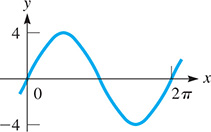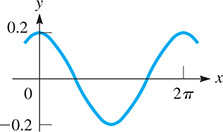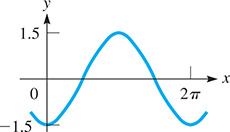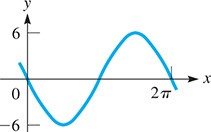10.1 Graphs of y = a sin x and y = a cos x
Graphs of and • Amplitude • Graphs of and
When plotting and sketching the graphs of the trigonometric functions, it is normal to express the angle in radians. By using radians, both the independent variable and the dependent variable are real numbers. If necessary, review Section 8.3 on radian measure of angles.
NOTE
[Therefore, it is necessary to be able to readily use angles expressed in radians.]
In this section, the graphs of the sine and cosine functions are shown. We begin by making a table of values of x and y for the function where x and y are used in the standard way as the independent variable and dependent variable. We plot the points to obtain the graph in Fig. 10.1.
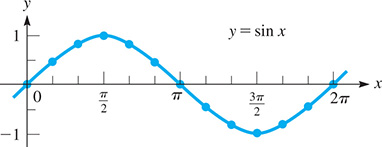
Fig. 10.1
| x | 0 | ||||||
| y | 0 | 0.5 | 0.87 | 1 | 0.87 | 0.5 | 0 |
| x | ||||||
| y | 0 |
The graph of may be drawn in the same way. The next table gives values for plotting the graph of and the graph is shown in Fig. 10.2.

Fig. 10.2
| x | 0 | ||||||
| y | 1 | 0.87 | 0.5 | 0 |
| x | ||||||
| y | 0 | 0.5 | 0.87 | 1 |
The graphs are continued beyond the values shown in the tables to indicate that they continue indefinitely in each direction. To show this more clearly, in Figs. 10.3 and 10.4, note the graphs of and from to

Fig. 10.3

Fig. 10.4
From these tables and graphs, it can be seen that the graphs of and are of exactly the same shape (called sinusoidal), with the cosine curve displacement units to the left of the sine curve. The shape of these curves should be recognized readily, with special note as to the points at which they cross the axes. This information will be especially valuable in sketching similar curves, because the basic sinusoidal shape remains the same.
NOTE
[It will not be necessary to plot numerous points every time we wish to sketch such a curve. A few key points will be enough.]
AMPLITUDE
To obtain the graph of note that all the y-values obtained for the graph of are to be multiplied by the number a. In this case, the greatest value of the sine function is The number is called the amplitude of the curve and represents the greatest y-value of the curve. Also, the curve will have no value less than This is true for as well as
EXAMPLE 1 Plot graph of y = a sin x
Plot the graph of
Because the amplitude of this curve is This means that the maximum value of y is 2 and the minimum value is The table of values follows, and the curve is shown in Fig. 10.5.

Fig. 10.5
| x | 0 | ||||||
| y | 0 | 1 | 1.73 | 2 | 1.73 | 1 | 0 |
| x | ||||||
| y | 0 |
EXAMPLE 2 Plot graph of y = a cos x
Plot the graph of
In this case, and this means that the amplitude is Therefore, the maximum value of y is 3, and the minimum value of y is The table of values follows, and the curve is shown in Fig. 10.6.

Fig. 10.6
| x | 0 | ||||||
| y | 0 | 1.5 | 2.6 | 3 |
| x | ||||||
| y | 2.6 | 1.5 | 0 |
NOTE
[Note that the effect of the negative sign with the number a is to invert the curve about the x-axis.]
From the previous examples, note that the function has zeros for and that it has its maximum or minimum values for The function has its zeros for and its maximum or minimum values for This is summarized in Table 10.1. Therefore, by knowing the general shape of the sine curve, where it has its zeros, and what its amplitude is, we can rapidly sketch curves of the form and
Table 10.1
| zeros | max. or min. | |
| max. or min. | zeros | |
Because the graphs of and can extend indefinitely to the right and to the left, we see that the domain of each is all real numbers. We should note that the key values of and are those only for x from 0 to Corresponding values ( and their negatives) could also be used. Also, from the graphs, we can readily see that the range of these functions is
EXAMPLE 3 Using key values to sketch graph
Sketch the graph of
First, we set up a table of values for the points where the curve has its zeros, maximum points, and minimum points:
| x | 0 | ||||
| y | 40 max. | 0 | 0 | 40 max. |
Now, we plot these points and join them, knowing the basic sinusoidal shape of the curve. See Fig. 10.7.
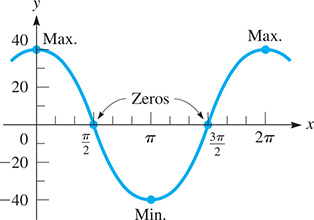
Fig. 10.7
The graphs of and can be displayed easily on a calculator. In the next example, we see that the calculator displays the features of the curve we should expect from our previous discussion.
EXAMPLE 4 Displaying graphs on calculator—water wave
A certain water wave can be represented by the equation (measurements in ft). Display the graph on a calculator.
Using radian mode on the calculator, Fig. 10.8 shows the calculator view for the key values in the following table:
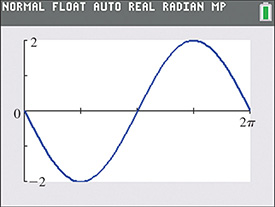
Fig. 10.8
| x | 0 | ||||
| y | 0 | 0 | 2 max. | 0 |
We see the amplitude of 2 and the effect of the negative sign in inverting the curve.
Exercises 10.1
In Exercises 1 and 2, graph the function if the given changes are made in the indicated examples of this section.
In Example 2, if the sign of the coefficient of cos x is changed, plot the graph of the resulting function.
In Example 4, if the sign of the coefficient of sin x is changed, display the graph of the resulting function.
In Exercises 3–6, complete the following table for the given functions and then plot the resulting graphs.
| x | 0 | ||||||||
| y |
| x | ||||||||
| y |
In Exercises 7–22, give the amplitude and sketch the graphs of the given functions. Check each using a calculator.
Although units of are convenient, we must remember that is only a number. Numbers that are not multiples of may be used. In Exercises 23–26, plot the indicated graphs by finding the values of y that correspond to values of x of 0, 1, 2, 3, 4, 5, 6, and 7 on a calculator. (Remember, the numbers 0, 1, 2, and so on represent radian measure.)
In Exercises 27–32, solve the given problems.
Find the function and graph it for a function of the form that passes through
Find the function and graph it for a function of the form that passes through
The height (in ft) of a person on a ferris wheel above its center is given by where t is the time (in s). Graph one complete cycle of this function.
The horizontal displacement d (in m) of the bob on a large pendulum is where t is the time (in s). Graph two cycles of this function.
The graph displayed on an oscilloscope can be represented by Display this curve on a calculator.
The displacement y (in cm) of the end of a robot arm for welding is where t is the time (in s). Display this curve on a calculator.
In Exercises 33–36, the graph of a function of the form or is shown. Determine the specific function of each.
Each ordered pair given in Exercises 37–40 is located on the graph of either or where the amplitude is Use the trace feature on a calculator to determine the equation of the function that contains the given point. (All points are located such that the x value is between and )
(2.07, 1.20)
Answers to Practice Exercise
x 0 y 0 0 6 max. 0

